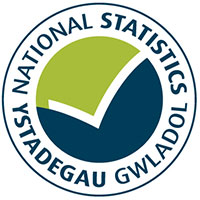Data on ethnicity, disability status, marital status and religion produced from the Annual Population Survey for 2017 to 2019.
This is not the latest release in the series: Equality and diversity statistics
Main points
Ethnicity
- 94.8% of the population of Wales described their ethnic group as White. This varied by region from 97.3% of the population in North Wales to 93.3% in South East Wales.
- 5.2% of the population described themselves as Asian, Black, ‘Mixed/Multiple ethnic group’ or ‘Other ethnic group’. Those describing their ethnic group as Asian were the second largest ethnic group in Wales (2.4% of the population).
- Over the last six years, the proportion of the population describing themselves as Asian, Black, ‘Mixed/Multiple ethnic group’ or ‘Other ethnic group’ has steadily increased across all regions.
- The percentage of people identifying as White increased by age group (from 91.0% for those aged under 16 to 99.0% for those aged 65 and over). However this pattern was reversed for all other ethnic groups.
Disability
- Just over a fifth of the population aged 16 to 64 (21.8%) identified as disabled. This proportion has marginally increased over time. However, a higher proportion of women than men identified as disabled (24.3% compared with 19.3%). The proportion of people identifying as disabled increased by age group for both sexes.
- North Wales had the lowest proportion of people identifying as disabled (19.2%). Whereas South East Wales and Mid/West Wales had similar proportions (22.3% and 23.0% respectively).
Religion
- Just under half of the population of Wales identified as Christian (47.9%). Whereas 47.3% of the population stated they had no religion. However, these figures varied by region. In North Wales, 55.1% of the population identified as Christian and 41.8% stated they had no religion. This compares with 43.8% and 50.6% of people in South East Wales respectively.
- Over time, the numbers of people in Wales identifying as Christian have steadily decreased whereas the numbers of people stating they had no religion have steadily increased.
- Over 55,000 people (1.8% of the population) identified as Muslim. Over two thirds (69%) of the Muslim population in Wales were domiciled in South East Wales.
- A higher proportion of women than men identified as having a religion (56.5% compared with 48.3%) and the proportion of people identifying as having a religion generally increased by age group. This contrasts with the proportion of people stating they had no religion which notably decreased as age increased.
Marital status
- Nearly half of the population aged 16 and over in Wales (48.3%) were married or in a civil partnership whereas over a third of the population (34.7%) were single.
- A slightly lower proportion of the population of South East Wales were married (47.3%) compared with Mid/West Wales and North Wales (48.7% and 49.8% respectively).
- A higher proportion of people in South East Wales were single than the rest of Wales (36% compared with 33% in both Mid/West Wales and North Wales).
- A higher proportion of men were married than women (49.6% compared with 47.0%). However, a higher proportion of women were widowed or surviving a civil partnership (9.3% compared with 3.8% of men) or divorced (12.3% compared to 8.4% of men).
Further information
The Annual Population Survey (APS) samples around 18,000 households in Wales every year. However, the sample sizes for people with ‘protected characteristics’ (as specified in the Equality Act 2010) can be relatively small. Therefore, to improve the evidence base on people with ‘protected characteristics’, more detailed analysis has been produced from a pooled dataset which combines 3 years of APS data. This analysis can be found on our StatsWales website.
The Welsh Government accepts the social definition of disability, in which it is recognised that barriers in society act to disable people who have impairments or health conditions or who use British Sign Language. The Annual Population Survey captures data during the interview based around the Equality Act 2010 which uses the medical definition of disability ('a physical or mental impairment which has a substantial and long-term impact on a person’s ability to carry out normal day to day activities').
Collecting and presenting data on race and ethnicity is complex because of the subjective, multifaceted and changing nature of the concepts involved. The Annual Population Survey captures data using the Government Statistical Service’s recommended harmonised ethnic group question ('What is your ethnic group?').
Additional analysis of protected characteristics by area deprivation has now also been published as part of a suite of follow-on outputs for the Welsh Index of Multiple Deprivation 2019.
Contact
Scott Clifford
Telephone: 0300 025 3234
Email: stats.inclusion@gov.wales
Rydym yn croesawu galwadau a gohebiaeth yn Gymraeg / We welcome calls and correspondence in Welsh.

